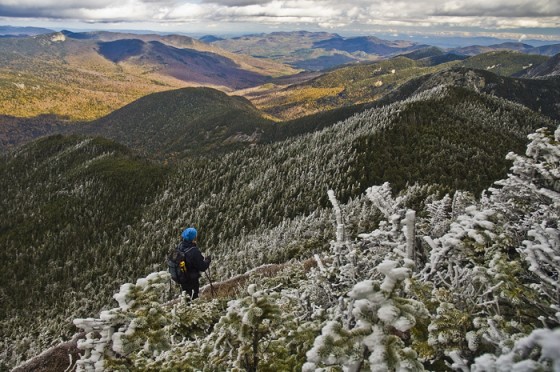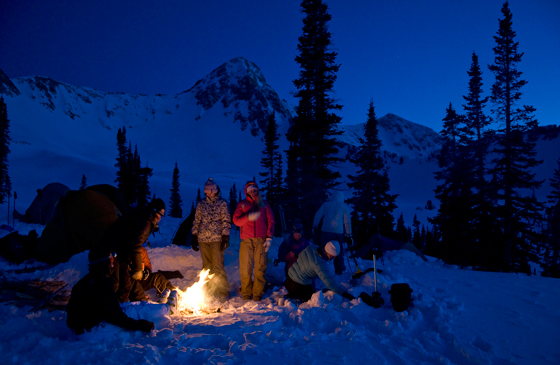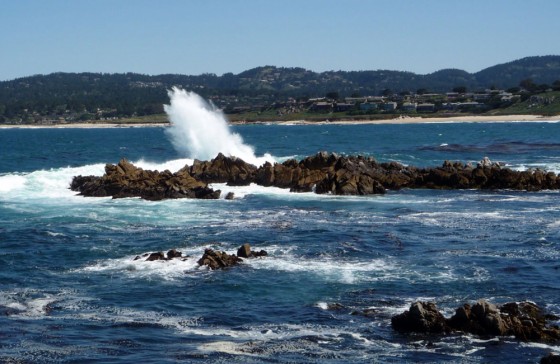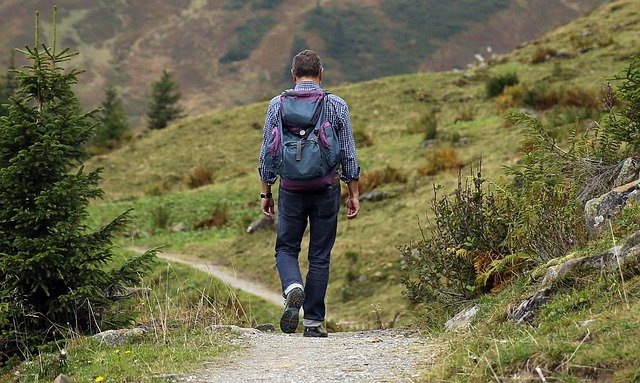Yellow taxi cabs honking in stand-still traffic, intimidating buildings that loom so tall you feel like an ant, after-hours nightclubs and late night pizza stops; This is what people picture when they think of New York. While the state does offer a “big city, bright lights” spot on the map, it has a lot more to offer aside from art galleries, fashion inspiration, and the world’s best pizza, especially in terms of hiking.
New York is a huge state encompassing many more areas than just the five boroughs. Some beautiful and natural scenery can be found here. Unfortunately, many people who come to visit the area miss out on the opportunity to explore the more natural side of New York. There are myriad parks and trails to discover in this state, so many that it is a tall order to name even a fraction of them in one article. However, with the understanding that we’re only touching on a few highlights, here are some areas and trails to explore that offer a range of atmosphere and terrain.
Beach Hiking on Long Island
Long Island, NY, is located right outside of Manhattan and is easily accessible by train. If you go way out to the Eastern portions of the island, you will find tons of wineries offering tastings and cheeses, farm-stands selling fresh fruits and vegetables, homemade pies and jams, and live music on the water. There is a very upper-crust quaintness about this area, and it is home to a lot of natural beauty.
One of the most scenic hikes that is good for both hikers who want to relax and enjoy the ambiance as well as the more hardcore looking for a challenge is Hither Hills Park in Montauk, NY. There are various trails marked for different skill levels, but all promise to have you scrambling for your camera. There are many different outlook points located on the trails that will allow you to view various coastlines, beach towns and islands. Listen to the seagulls as you watch them glide over Fort Pond Bay and take a snapshot of colorful boats docked in a nearby inlet.
What really sets Hither Hills Park apart is the fact that it encompasses such an array of scenery and terrain. One moment you can be walking through a thick forest, strolling past Oak trees and wading through lush fern beds. Moments later you may find yourself huffing up some sand dunes and emerging onto a hot, sunny beach with a coastal view. This is also ideal because you can cool down from your hike with a refreshing swim.
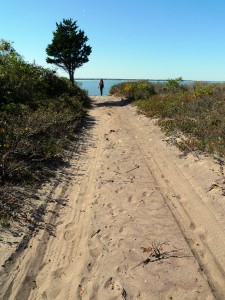
Hiking Hither Hills, on Long Island in New York. Photo: Daniel Huggard
A lesson in history also awaits you during your hiking adventure. First of all, you will get to experience Fort Pond Bay, which played a part in the American Revolutionary War, as was Culloden Point. In fact, one of the British ships, the HMS Culloden, had to be burned with its canons thrown overboard during the war. The debris from this incident is still there today, preserving history, in an underwater time capsule known as Marine Park.
During your hike, when passing these points of revolutionary history, look out at these landmarks and picture what it must have been like to be an American soldier fighting in the war, bombs exploding in the air as you risked your life trying to save your independence. Smell the blades of grass under your feet and the cool breeze coming off the water and realize that this is the same grass and the same water experienced by people in the 18th and 19th centuries. How might they have interpreted these tranquil stimulators of the senses? Was the cool breeze and dewy earth calming, a reminder of war, or maybe the smell of freedom?
Remember, this is only one hike of many located on Long Island. Other great hiking venues include Caleb State Park in Smithtown, Caumsett State Park in Huntington, Connetquot State Park in Oakdale, and Mashomack Preserve in Greenport.
Hiking in the Adirondack Mountains
Most people have heard of the Adirondacks, although when traveling to New York not many tourists list them as a must-see on their to-do list. Being that the Adirondacks span over 2,000 miles and are the largest trail system in the United States, this is surprising. It is also important to note that the mountains are easily accessibly by AMTRAK, major bus lines, airport and car rental from Manhattan.
Long Island trails offer an island or forest vibe, while hiking the Adirondacks is more of a mountain-trekking, high-peak experience.
Although the Adirondacks are rugged mountains, there are still trail options for all levels of hikers. If you are looking for an easy hike, one popular option is Cascade Mountain (4,098 feet). While this number may sound intimidating, it is entirely possible to accomplish if you are a beginner and/or do not have a full day to spare. What makes this venture stand out from the rest is the 360-degree view you are rewarded once reaching the summit. For someone looking for an easy hike with a bit more distance hiking to Cascade is still an option as you can add the Porter Mountain summit to your plan.
While you will get to experience forest paths and stone steps that seem like obstacle courses, the real draw for this hike are the views at the summit. Standing on top of a mountain, looking down on all of the natural, untouched beauty, you will really feel like you are part of this planet. The closer mountains in the range seem to burst a bright green color while the mountains behind it fade into icy blues and whites. The mountains appear to go on forever, leaving you speechless and wondering if it could be possible to hike each and every trail to fine exactly what magic lies at the end.
For more experienced hikers looking for a challenge as well as some solitude from the more touristy trails, Macomb Mountain is perfect. The Macomb hike, which is part of the Dix Mountain Range, takes about two days to complete.
Time is needed to reach the base camp, climb the mountain and then hike out. Macomb, which is 4,405 ft, is an unmarked trail with sections that are not maintained by any official organization, adding to its difficulty. However, just like with Cascade Mountain, the views at the summit are well worth the challenge as you view colors you have never before experienced in anything man made. Innocent purples, magnetic blues, lush greens and icy whites burst from the scenery. While one mountain may appear to be part of a sunny, spring afternoon there can be one adjacent that will have you picturing winters at the ski resort.
Hiking the Catskills
The Catskill Mountains are well known for their laid-back beauty and the variety of hiking opportunities they offer. Spread between four counties, the area is composed of over 6,000 square miles of rivers forests, and mountain peaks that exceed altitudes of 3,500-feet.
The Scenic Trails of the Catskills in Delaware County offer gentle hiking trails for beginners, with 19 miles of pathway to cover. For the more experienced hiker, the Hudson Mountain Wild Forest area in Greene County is composted of 11,000 acres of rough and mountainous terrain. On route, called Devil’s Path, is a challenging 24-mile trail that will have you hiking over five mountain peaks. Other areas options of the Catskills include Balsam Lake Mountain Wild Forest in Ulster County and Willowemoc Wild Forest in Sullivan County are more suited for moderate hikers.
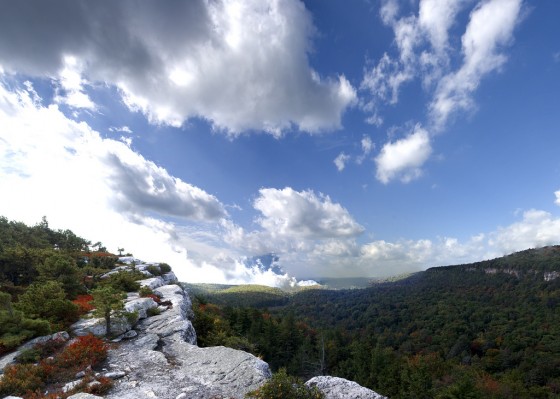
View of Minnewaska from Gertrude’s Nose Trail. Photo: Katy Silberger
A great time to hike the Catskill Mountains is in the Fall, not only because of the weather conditions, but also because of the picture-perfect foliage you will be immersed in. Surrounding greenery is decorated with bright reds, crisp oranges, and glowing yellows that will make you feel like you are part of a Bob Ross painting.
Moreover, majestic waterfalls and woodland creeks will place the painting in the movie where magic is actually possible, while mountain gorges will have your palms sweating as you look down from the top.
To get to the Catskill Mountains from New York City, there are various options. If you decide to fly, regional airports include Albany, Binghampton, Newburgh (Stewart Airport), and Sullivan counties are commuter and regional service. In terms of buses, Adirondack/Pine Hill Trailways (1-800-858-8555) and Shortline Bus (1-800-631-8405) offer services from New York City. There are also rail options, including AMTRAK (1-800-872-7245) and Metro-North (1-800-METRO-INFO).
Hiking the White Mountain National Forest
The White Mountain National Forest, which puts an emphasis on natural beauty, is located in Northern New Hampshire and southwestern Maine and contains over 12,000 miles of hiking trails. This is a great spot for hiking, especially because it is home to an array of unique features.
One draw to the White Mountain National Forest is Mount Washington, which is the highest peak north of the Smokey Mountains and east of the Mississippi. There is also the Alpine Surroundings, with are eight square miles, making it the largest area east of the Rocky Mountains and south of Canada.
Moreover, a must-see when taking a trip to the White Mountain National Forest is the Kancamagus Scenic Byway. Although most people drive this, it is 34 miles long and gives visitors a full-sense of the region as it encompasses the heart of the White Mountains. When exploring this Byway, you will travel through forests, old logging roads, and Indian hunting paths. The culture, history, and economics of New Hampshire can all be learned about on the Kancamagus Scenic Byway, so make sure to take your time and explore.
When hiking this area, not only will you be enchanted by its natural beauty, you will also be able to experience an array of wildlife. Almost 200 species of birds live here, as well as black bears, frogs, turtles, snakes, and various mammals.
To get to the White Mountain National Forest from New York City by airplane, fly into either the Manchester-Boston Regional Airport or the Pease International Airport. There are also myriad bus companies that travel from New York to Boston, including MegaBus (1-877-GO2-MEGA), Greyhound Express (1-800-231-2222), Boltbus (1-877-BOLTBUS), and Fung Wah Bus (1-212-925-8889). You can also take an AMTRAK train to reach the destination.
Green Mountain National Forest
When hiking in the Green Mountain National Forest, you can expect an array of experiences, from being out in the open over exposed mountain cliffs to the more secluded privacy of the forest. This forest is composed of over 40,000 acres of trail with a mission to sustain, enhance, and protect forest ecosystems, according to the Forest Service, an agency of the US Department of Agriculture.
Each season at Green Mountain National Forest brings its own unique enhancement to the area. Many hikers love to visit during the Fall, when the colors of nature are at their most bright and diverse, full of rustic energy that compliments the experience. During Winter, skiers, snowboarders, and snowmobile enthusiasts, and snowshoe lovers frequent the area. Once Spring comes, hikers can expect to enjoy seeing the forest come back to life from the dead of Winter, with blooming flora and chirping birds. Summer is a popular season for hikers, due to the sunny weather and feeling of optimism and adventure that comes with the season.
Green Mountain National Forest has an array of hiking trails that range from easy to difficult and also include unique features. While you will be able to see the usual mountain peaks, streams, woods, and waterfalls, some of these trails offer truly unique features. For example, the Robert Frost Interpretive Area is an easy 1.2 mile loop that includes berry picking and poetry. Because the trail was created to honor the poet, several of his poems are mounted along the trail. Moreover, the White Rocks/Ice Beds Trail includes spectacular views and a natural phenomenon. This moderate-difficult hike is 0.4 miles round trip to look out points, and 1.8 miles to see ice beds. Because the ice beds are protected in the deep recesses of rock piles, it lasts late into the summer until it slowly melts.
To get to Green Mountain National Forest from New York City, AMTRAK offers a rail service daily arriving in Waterbury, Vermont, around 7:30PM. If you are looking to fly into the area, Burlington International Airport is your most convenient point of access.
Wetland Forest Hiking in Cayuga County
Bear Swamp State Forest, located in Cayuga County, has 3,280 acres for you to explore and, at 1,860-feet high, is the highest point within the area. From Manhattan, this area is easily accessible via the New York State Thruway. What is great about this park is that there are trails marked by different color blazes and numbers, allowing you to create your own personalized hike based on how many miles you would like to accomplish.
While the previous hikes mentioned present challenges such as rock climbing, steep mountain hills, or trudging through sand dunes, Bear Swamp State Forest offers walking through the thick forest broken by wetlands and creeks. While you may get the chance to look out on the peaceful Skaneateles Lake, prepare to be wrapped in the blanket of the trees as you get to know the inner-workings of the woods. For many, hiking in Bear Swamp is a reflective experience as the sounds of nature and the stillness of the trees allow the mind to relax and take in the vastness of the forest.
Most of the trails here are well-maintained, with clear paths for a leisurely yet sometimes challenging experience. Trails can be steep at times, and some unexpected surprises await you depending on which trails you choose, such as creek crossings and mud holes. For the most part, however, beginners should have no problems.
This page is an archive. To learn more about archive pages click here
The responses below are not provided, commissioned, reviewed, approved, or otherwise endorsed by any financial entity or advertiser. It is not the advertiser’s responsibility to ensure all posts and/or questions are answered.
